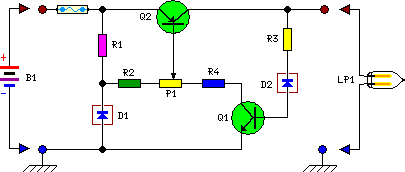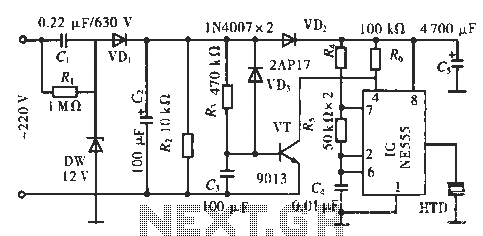
water level indicator circuit using cmos ics

A low-cost water level indicator circuit can be designed using this schematic. This water level indicator utilizes a CMOS IC, the CD4066, to indicate the amount of water present in an overhead tank and provides an alarm when the tank is full. When the tank is empty, the wires in the tank are open-circuited, and a 180K resistor pulls the switch low, resulting in the LEDs being off. As water begins to fill the tank, the wire connected to switch S1 and the positive supply is shorted by the water, closing switch S1 and turning LED1 on. As the water level rises, LEDs 2, 3, and 4 illuminate sequentially. Once the tank is full, the water pulls the base of the transistor BC148 high, saturating the transistor and activating the buzzer. The buzzer can be turned off by opening the SPST switch.
The water level indicator circuit employs a CMOS IC CD4066, which functions as a quad bilateral switch, allowing for the control of multiple indicators based on water level changes. The circuit is designed with a series of resistors and LEDs that visually represent the water level in the tank. The 180K resistor plays a crucial role in ensuring that when the water level is low, the circuit remains inactive, keeping the LEDs off.
As water enters the tank, it creates a conductive path between the wire connected to switch S1 and the positive supply. This action closes switch S1, allowing current to flow and illuminating LED1, which indicates the initial water level. As the water continues to rise, additional wires connected to subsequent switches (S2, S3, and S4) are shorted, sequentially lighting up LEDs 2, 3, and 4, thus providing a clear visual indication of the water level.
The circuit also incorporates a BC148 transistor, which acts as a switch for the buzzer. When the water level reaches its maximum height, it pulls the base of the BC148 high, causing the transistor to saturate. This saturation allows current to flow through the buzzer, activating it and providing an audible alarm to signal that the tank is full. To deactivate the buzzer, the user must open the SPST switch, which interrupts the circuit and stops the buzzer from sounding.
This design is advantageous due to its simplicity, low cost, and effectiveness in providing both visual and audible alerts for water level management in overhead tanks. The use of a CMOS IC ensures low power consumption, making the circuit suitable for continuous operation in various applications.A very simple low cost water level indicator circuit can be designed using this schematic circuit. This water level indicator is based on a simple CMOS IC CD4066 and indicates the amount of water present in the overhead tank and also gives an alarm when the tank is full. When the water is empty the wires in the tank are open circuited and the 180 K resistors pulls the switch low hence opening the switch and LEDs are OFF. As the water starts filling up, first the wire in the tank connected to S1 and the + supply are shorted by water. This closes the switch S1 and turns the LED1 ON. As the water continues to fill the tank, the LEDs2, 3 and 4 light up gradually. When the water is full, the base of the transistor BC148 is pulled high by the water and this saturates the transistor, turning the buzzer ON.
The SPST switch has to be opened to turn the buzzer OFF. 🔗 External reference
The water level indicator circuit employs a CMOS IC CD4066, which functions as a quad bilateral switch, allowing for the control of multiple indicators based on water level changes. The circuit is designed with a series of resistors and LEDs that visually represent the water level in the tank. The 180K resistor plays a crucial role in ensuring that when the water level is low, the circuit remains inactive, keeping the LEDs off.
As water enters the tank, it creates a conductive path between the wire connected to switch S1 and the positive supply. This action closes switch S1, allowing current to flow and illuminating LED1, which indicates the initial water level. As the water continues to rise, additional wires connected to subsequent switches (S2, S3, and S4) are shorted, sequentially lighting up LEDs 2, 3, and 4, thus providing a clear visual indication of the water level.
The circuit also incorporates a BC148 transistor, which acts as a switch for the buzzer. When the water level reaches its maximum height, it pulls the base of the BC148 high, causing the transistor to saturate. This saturation allows current to flow through the buzzer, activating it and providing an audible alarm to signal that the tank is full. To deactivate the buzzer, the user must open the SPST switch, which interrupts the circuit and stops the buzzer from sounding.
This design is advantageous due to its simplicity, low cost, and effectiveness in providing both visual and audible alerts for water level management in overhead tanks. The use of a CMOS IC ensures low power consumption, making the circuit suitable for continuous operation in various applications.A very simple low cost water level indicator circuit can be designed using this schematic circuit. This water level indicator is based on a simple CMOS IC CD4066 and indicates the amount of water present in the overhead tank and also gives an alarm when the tank is full. When the water is empty the wires in the tank are open circuited and the 180 K resistors pulls the switch low hence opening the switch and LEDs are OFF. As the water starts filling up, first the wire in the tank connected to S1 and the + supply are shorted by water. This closes the switch S1 and turns the LED1 ON. As the water continues to fill the tank, the LEDs2, 3 and 4 light up gradually. When the water is full, the base of the transistor BC148 is pulled high by the water and this saturates the transistor, turning the buzzer ON.
The SPST switch has to be opened to turn the buzzer OFF. 🔗 External reference





